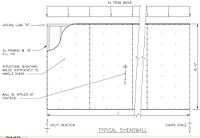
Photo from wikipedia
This contribution proposes the first three‐dimensional (3D) beam‐beam interaction model for molecular interactions between curved slender fibers undergoing large deformations. While the general model is not restricted to a specific… Click to show full abstract
This contribution proposes the first three‐dimensional (3D) beam‐beam interaction model for molecular interactions between curved slender fibers undergoing large deformations. While the general model is not restricted to a specific beam formulation, in the present work, it is combined with the geometrically exact beam theory and discretized via the finite element method. A direct evaluation of the total interaction potential for general 3D bodies requires the integration of contributions from molecule or charge distributions over the volumes of the interaction partners, leading to a six‐dimensional integral (two nested 3D integrals) that has to be solved numerically. Here, we propose a novel strategy to formulate reduced section‐section interaction laws for the resultant interaction potential between a pair of cross‐sections of two slender fibers such that only two one‐dimensional integrals along the fibers' length directions have to be solved numerically. This section‐section interaction potential (SSIP) approach yields a significant gain in efficiency, which is essential to enable the simulation of relevant time and length scales for many practical applications. In a first step, the generic structure of SSIP laws, which is suitable for the most general interaction scenario (eg, fibers with arbitrary cross‐section shape and inhomogeneous atomic/charge density within the cross‐section) is presented. Assuming circular, homogeneous cross‐sections, in a next step, specific analytical expressions for SSIP laws describing short‐range volume interactions (eg, van der Waals (vdW) or steric interactions) and long‐range surface interactions (eg, Coulomb interactions) are proposed. Besides ready‐to‐use expressions for the total interaction potential, also the resulting virtual work contributions, its finite element discretizations, as well as a suitable numerical regularization for the limit of zero separation are derived. The validity of the SSIP laws, as well as the accuracy and robustness of the general SSIP approach to beam‐beam interactions, is thoroughly verified by means of a set of numerical examples considering steric repulsion, electrostatic, or vdW adhesion.
Journal Title: International Journal for Numerical Methods in Engineering
Year Published: 2020
Link to full text (if available)
Share on Social Media: Sign Up to like & get
recommendations!